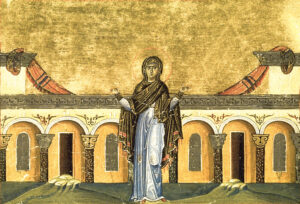
A 10th century CE depiction of Amma Syncletica of Alexandria (c. 270 – c. 350 CE), one of the early leaders of Christian Monasticism. (Vatican Libraries)
The role of women in the Church has been a subject of theological debate and discussion for centuries. The traditional perspective, rooted in scriptural interpretation and early church writings, posits that women should not hold pastoral authority over men. Instead, their leadership roles should be confined to guiding other women and children. This article aims to explore and support this viewpoint, drawing from key biblical texts and early church fathers’ teachings.
Biblical Foundations
The New Testament provides several passages that have traditionally been interpreted to delineate the roles of women in the Church. One of the most frequently cited is Paul’s first Epistle to Timothy:
"In like manner also, that women adorn themselves in modest apparel, with shamefacedness and sobriety; not with broided hair, or gold, or pearls, or costly array; But (which becometh women professing godliness) with good works. Let the woman learn in silence with all subjection. But I suffer not a woman to teach, nor to usurp authority over the man, but to be in silence. For Adam was first formed, then Eve. And Adam was not deceived, but the woman being deceived was in the transgression. Notwithstanding she shall be saved in childbearing, if they continue in faith and charity and holiness with sobriety."
– 1 Timothy 2:9-15
This passage is often interpreted as an instruction for women to adopt a posture of humility and subjection, emphasizing modesty and good works over outward adornment. The directive that women should not “teach, nor to usurp authority over the man” has been foundational in shaping the traditional stance that women should not hold pastoral authority over men.
Early Church Writings
Early church fathers also provided guidance on the role of women within the Church. In 1 Clement 1:3, the instructions given to women emphasize modesty, obedience, and managing household affairs:
“For ye did all things without respect of persons, and ye walked after the ordinances of God, submitting yourselves to your rulers and rendering to the older men among you the honor which is their due. On the young too ye enjoined modest and seemly thoughts: and the women ye charged to perform all their duties in a blameless and seemly and pure conscience, cherishing their own husbands, as is meet; and ye taught them to keep in the rule of obedience, and to manage the affairs of their household in seemliness, with all discretion.”
Similarly, 1 Clement 21:6-9 outlines the virtues expected of women, including purity, gentleness, and silence, further reinforcing the idea of women playing supportive, rather than authoritative, roles within the Church.
Theological Interpretations
The theological rationale for this traditional perspective often hinges on the order of creation and the fall, as outlined in 1 Timothy 2. The argument is that Adam was created first, and Eve was deceived, thus establishing a divine order in which men hold primary authority in teaching and leadership within the Church.
Justin Martyr, in his “Dialogue with Trypho,” expands on the role of Christ and the Church, emphasizing the submission to God’s order and the distribution of roles according to divine will. This perspective underscores that Christ, although embodying ultimate power and authority, submitted to human experiences and structures for the sake of humanity, setting a precedent for hierarchical roles within the Church.
Practical Implications
The practical application of this traditional viewpoint is evident in many conservative Christian denominations where women are encouraged to engage in ministry roles that focus on teaching other women, mentoring youth, and participating in various service-oriented capacities. The roles of deaconess, women’s ministry leaders, and children’s ministry directors are often filled by women, emphasizing their vital contributions without stepping into pastoral or elder positions over men.
Conclusion
The traditional perspective on the role of women in the Church is deeply rooted in scriptural interpretation and early church teachings. It emphasizes a clear distinction between the roles of men and women, advocating for women’s leadership within specific, gender-aligned contexts. While contemporary discussions continue to evolve, this traditional viewpoint remains a significant and influential interpretation within many Christian communities.
By adhering to these scriptural and historical foundations, the Church seeks to honor the distinct and complementary roles that men and women play in fostering a spiritually robust and orderly community.









